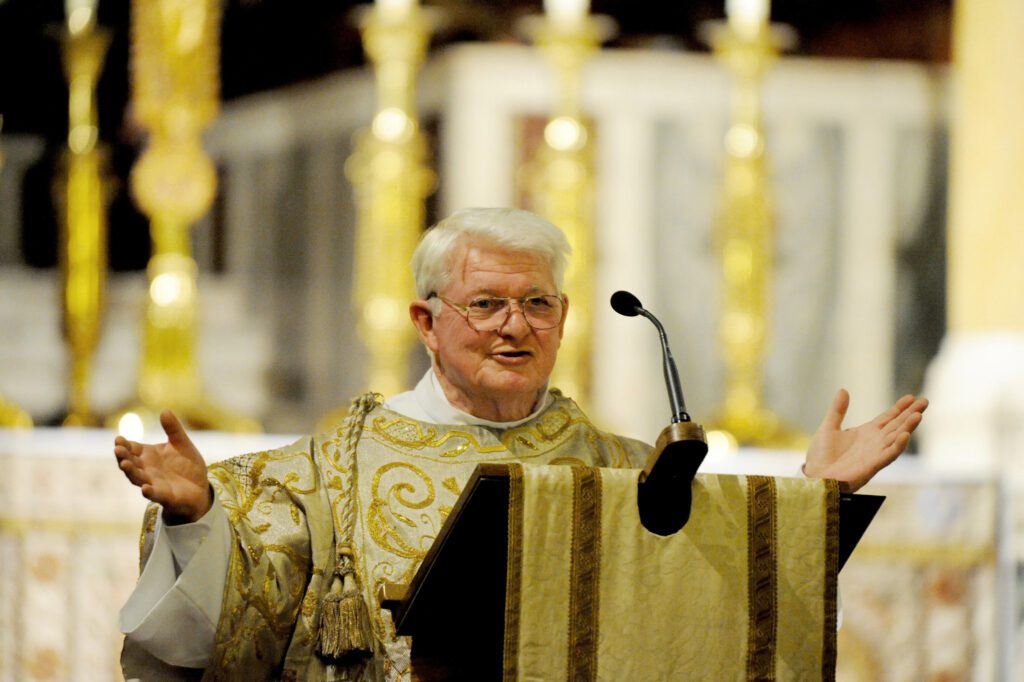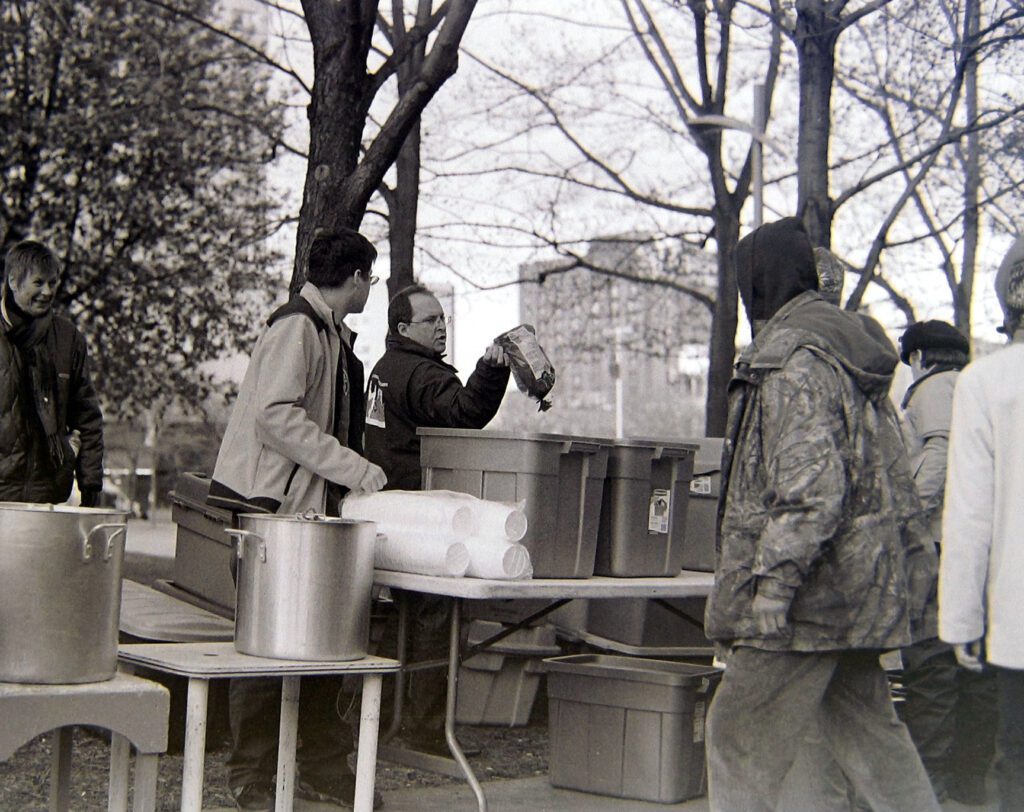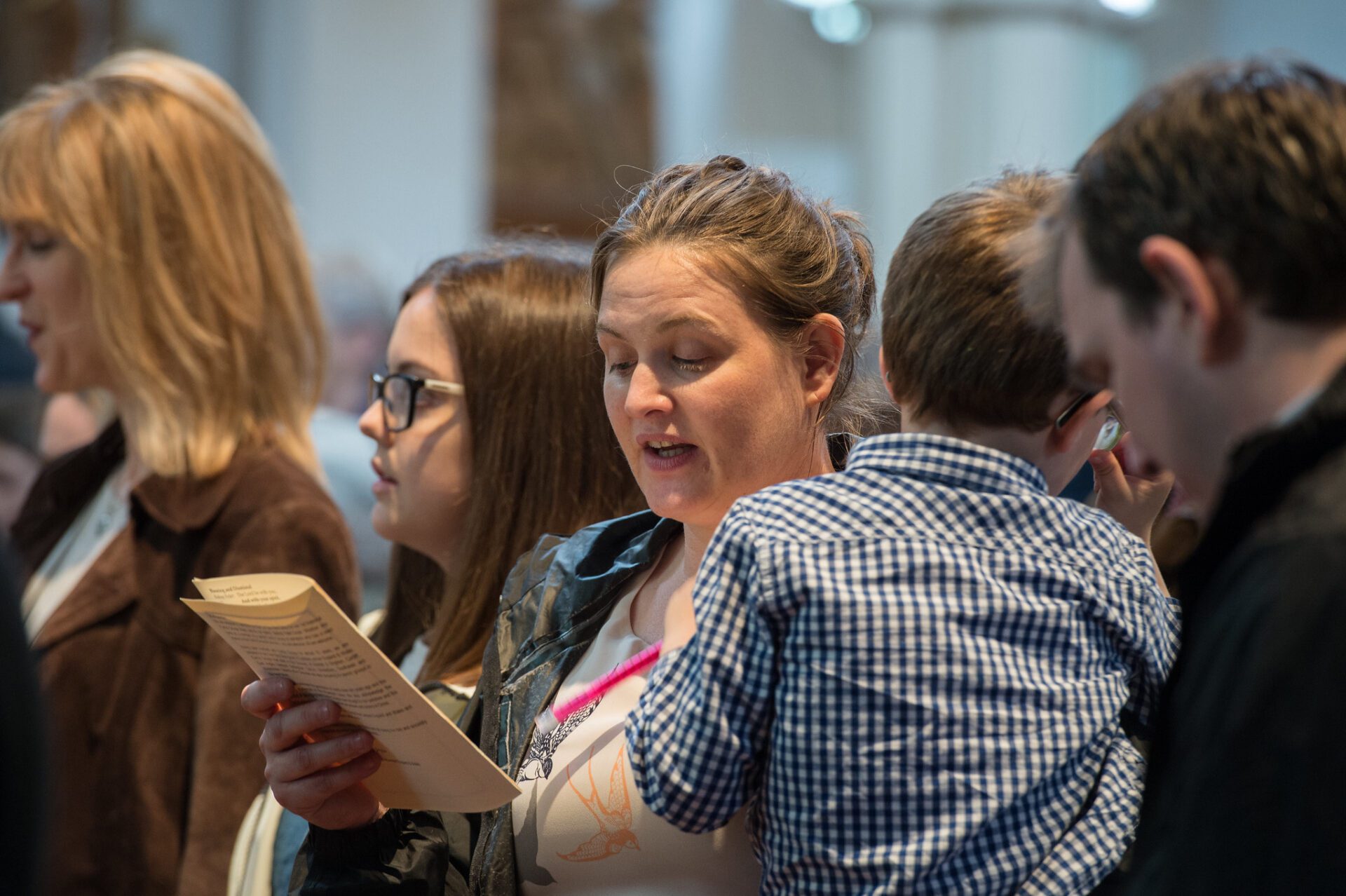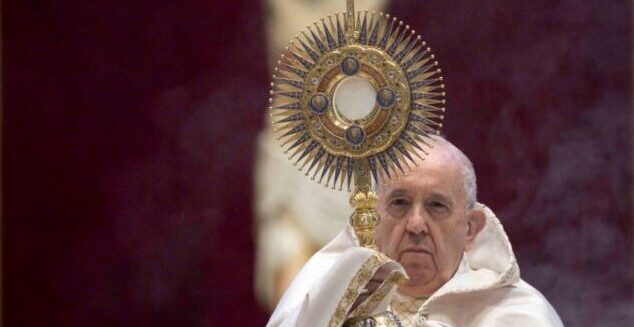The Parish Year of the National Eucharistic Revival has just begun. It will lead us to the first National Eucharistic Congress in the United States in nearly 50 years. This moment in the life of the Church is a tremendous opportunity to kickstart the renewal of our parishes, beginning with and pointing back to Christ’s true presence and saving action in the Eucharist.
The National Eucharistic Revival has offered four invitations to parishes for this year. Here are some concrete ways to maximize them in your parish:
Invitation 1: Reinvigorate Worship through the Ars Celebrandi
Beginning with the source and summit of the Church’s life and mission, the first invitation is “reinvigorating worship” with a special attentiveness to the ars celebrandi (art of celebration) in the liturgy. The Church tells us that when the liturgy is celebrated beautifully and faithfully, each part of it is enabled to “shine forth with a noble simplicity” (“Ritus nobili simplicitate fulgeant,” see Sacrosanctum Concilium, 34), radiating the invisible spiritual realities of the liturgy more powerfully and attractively to all.
The National Eucharistic Revival has offered four invitations to parishes for this year.
Put simply, celebrating the liturgy beautifully, with faithful attention to liturgical norms, makes the Light of Christ shine more brightly in our celebrations of the Mass. And our parishioners, with the help of mystagogical catechesis, will be drawn more powerfully toward that light—toward Christ himself. Here are some ways that you can foster a renewed ars celebrandi in your parish this year:
Reread the General Instruction of the Roman Missal (GIRM) as a parish staff. The GIRM not only tells us how to celebrate the liturgy rightly, but it also gives us the why. Be sure to discuss both. As Pope Benedict XVI reminded us, “the primary way to foster the participation of the People of God in the sacred rite is the proper celebration of the rite itself. The ars celebrandi is the best way to ensure their actuosa participatio (actual participation)” (Sacramentum Caritatis, 38).

Sing the Order of Mass. The Church teaches us that the liturgy is meant to be sung. Singing the Order of Mass—those unchanging parts from day to day, including the dialogues and responses—is the most important song of the liturgy, and it only requires the voice of the priest celebrant and a few people in the pews. The Order of Mass contains the simplest melodies in the sung liturgy that virtually anyone can sing easily and well. They are all contained in the Roman Missal, and numerous practice recordings can be found for each part online. When we sing the liturgy, “minds are more easily raised to heavenly things by the beauty of the sacred rites, and the whole celebration more clearly prefigures that heavenly liturgy which is enacted in the holy city of Jerusalem” (Musicam Sacram, 5). This is why the Church stresses that “pastors of souls will therefore do all they can to achieve [the sung] form of celebration” (ibid.).
The primary way to foster the participation of the People of God in the sacred rite is the proper celebration of the rite itself.
–Pope Benedict XVI
Sing the Communion Antiphon. Beyond singing the Order of Mass, which constitutes the first degree of importance in the sung liturgy, the Church also encourages parishes to sing the parts of the Ordinary and the Proper of the Mass. To do so means that we are truly singing the liturgy itself and not merely singing songs from outside of the liturgy within the Mass. One of the easiest places to begin singing the Proper of the Mass (beyond the Responsorial Psalm and Alleluia) is with the Communion Antiphon. This proper antiphon changes from day to day, much like the readings and orations of the Mass. It contains a short passage of scripture that often quotes or references the Gospel of the day, or that otherwise penetrates the heart of the mystery being celebrated for each Mass. In between repetitions of the antiphon, verses from a psalm are sung by the cantor or choir. The GIRM tells us that the Communion Chant begins as soon as the priest receives the sacrament, and the antiphon can be sung by a cantor alone before a communion hymn, with or without verses, or it can be sung with several verses during the entire communion procession. Hundreds of parishes already use Source and Summit’s online resource to find the right antiphon settings for their parish, whether they are simple settings for the congregation, tone-based settings, or more elaborate settings for more experienced choirs and cantors. Singing the Communion Antiphon throughout the Parish Year of the Eucharistic Revival can help those in the pews to draw their minds and hearts closer to Jesus in the Eucharist as they sing the words the Church gives us to sing while they approach the altar to receive communion.
Choose (or add) one Mass to emphasize beauty. A tried and true strategy for renewing the ars celebrandi on the parish level is to introduce enhancements to the liturgy without necessarily taking away what is already comfortable and familiar to many, and always with the help of ample catechesis. One effective way to do this is to choose a single Mass, or even to add one to the parish Mass schedule (such as a weekday evening candlelight Mass), and to focus on several aspects of the ars celebrandi there. What parishes often find is that these Masses, which are filled with beautiful sacred music, increased reverence, and attention to the solemn celebration of the liturgy, begin to fill up quickly with young and faithful families that are yearning for beauty and reverence in the liturgy. These smaller groups within the larger community become an agent for broader parish renewal as the fruits that pour forth from this microcosm begin to influence the parish culture as a whole.

Invitation 2: Personal Encounter with Jesus in the Eucharist Outside of Mass
While the liturgy is the “summit toward which the activity of the Church is directed” and the “font from which all her power flows” (Sacrosanctum Concilium, 10), the Church also tells us that “the sacred liturgy does not exhaust the entire activity of the Church” (ibid., 9). The Catechism of the Catholic Church stresses that the liturgy “must be preceded by evangelization, faith, and conversion. It can then produce its fruits in the lives of the faithful” (1072).
It follows that the second invitation of the Parish Year of the Eucharistic Revival is to help build Eucharistic faith and devotion in our parishioners through opportunities for personal encounter with Jesus in the Eucharist outside of the context of the Mass. Here are some suggestions for your parish:
Host monthly evenings of Eucharistic adoration with devotional music and spiritual reflections. Devotional music has the power to stir faith, love, and devotion in our souls, and to prepare us well to participate more deeply in the sacred liturgy, which ultimately transcends the devotional realm. A monthly evening of Eucharistic adoration might feature music for prayer that is not liturgical in nature, but that helps open hearts to Christ’s presence in the Eucharist. Because of music’s personal nature, the faithful can become very personally attached to devotional music, but our task as parish leaders should be to help guide this faith and devotion toward its consummation in the Eucharistic liturgy.
A monthly evening of Eucharistic adoration might feature music for prayer that is not liturgical in nature, but that helps open hearts to Christ’s presence in the Eucharist.
Orient devotional events back toward the liturgy. One way to help transition our parishioners from a profound personal encounter with Christ in Eucharistic adoration to a deeper participation in the liturgy could be through the use of more solemn Eucharistic hymns and chants, such as the chant form of the O Salutaris Hostia and Tantum Ergo at the beginning and end of an adoration event. A parish schola might even sing some sacred polyphony during these evenings, alongside a procession of the monstrance through the church with ample incense, led by vested clergy and servers. The prayers of Benediction, including the Divine Praises, can be fully chanted as well. The Adoremus in aeternum could replace Holy God, We Praise Thy Name. All of these efforts can both emphasize the powerful elements of devotion while also pointing back to the sacred liturgy as the summit and goal of the devotional life.
Institute extended periods of silent Eucharistic adoration. Extended periods of adoration could also be offered each week, where there is no music outside of the chants for Exposition and Benediction. This might include a Forty Hours’ Devotion monthly or from time to time.
Invitation 3: Robust Faith Formation through Preaching and Small Groups
The Catechism says that liturgical catechesis “aims to initiate people into the mystery of Christ (It is ‘mystagogy.’) by proceeding from the visible to the invisible, from the sign to the thing signified, from the ‘sacraments’ to the ‘mysteries’” (1075). Mystagogical catechesis can take place within the liturgy, especially through preaching, but also outside of the liturgy where there is more space to expound upon the mysteries and to discuss and integrate them more deeply into our understanding. Here are some ways to offer robust faith formation on the Eucharist during the Parish Year:

Integrate mystagogical catechesis into homilies throughout the year. Rather than simply offering a didactic homily series on Eucharistic theology or doctrine over the course of a few weeks, a mystagogical approach to homiletics throughout the entire year could expound on different dimensions of the Eucharist, in light of the various events of salvation. Consider preaching on more than the Lectionary readings, also looking at the Entrance and Communion Antiphons, as well as the Collects for source material (as permitted by the GIRM). Pope Benedict XVI’s profound reflection on mystagogical catechesis (in Sacramentum Caritatis, 64) and Pope Francis’s reflections on liturgical formation (in Desiderio Desideravi) could serve as an inspiration and a guide.
Offer a series of teachings on Eucharistic theology and doctrine outside of the Mass, with or without the help of a study program, and guide participants in small group discussions. These might even be hosted at the homes of parishioners and followed by a meal, even as a part of an organized supper club.
Teach your parishioners a classic Eucharistic hymn and sing it often at parish events. Hymns have a rich history of putting sound doctrine on our lips and in our minds. The Divine Office hymns of Corpus Christi, composed by St. Thomas Aquinas, are an excellent source for catechesis. Consider selecting one and singing it throughout the Parish Year at non-liturgical events.
Invitation 4: Missionary Sending of the People in the Pews
Sacramentum Caritatis summarizes the essential connection between the Mass and mission, saying: “The love that we celebrate in the sacrament [of the Eucharist] is not something we can keep to ourselves. By its very nature it demands to be shared with all. What the world needs is God’s love; it needs to encounter Christ and to believe in him. The Eucharist is thus the source and summit not only of the Church’s life, but also of her mission: ‘an authentically eucharistic Church is a missionary Church’” (84).
During the Parish Year, the U.S. Bishops through the Eucharistic Revival are calling on parishes to form missionary disciples—Eucharistic missionaries who have encountered Christ and who must share what they have seen with those around them in the world. Here are some practical suggestions for the fourth invitation:

Encourage parishioners to invite others to catechetical and devotional parish events. An instinct of Catholics often is to invite friends and family who may be far from the Church to “come back to Mass.” As sincere as this desire may be, it is likely that there is a need for evangelization, catechesis, and a personal encounter with Christ before our friends and loved ones might be able to approach the liturgy. And so, encouraging parishioners to invite those far from the Church to a dinner and catechetical study, or even to an adoration event, might be a more successful effort. In time, of course, we should hope to lead them back to the summit, “for the aim and object of apostolic works is that all who are made sons of God by faith and baptism should come together to praise God in the midst of His Church, to take part in the sacrifice, and to eat the Lord’s supper” (Sacrosanctum Concilium, 10).
Host parish events that serve those on the margins. During Lent, the parish might offer parishioners the opportunity to serve the poor at a soup kitchen, or to volunteer at a St. Vincent de Paul thrift store. You might organize a Christmas caroling event prior to Christmas that makes its way through the residential roads within the parish boundaries, inviting those in the neighborhood to a parish event. Whatever the case, consider creating or finding events for your parishioners where they can practice giving back the gifts that they have received so freely.
Recover the true and essential connection between the liturgy and social justice. In the Liturgical Movement of the early 20th century, liturgical renewal and social justice were seen as two sides of the same coin. In recent decades, the two have often been seen as being at odds with each other. In the parish year, we might take to heart Pope Francis’s call “to reach all the ‘peripheries’ in need of the light of the Gospel” (Evangelii Gaudium, 20), knowing that we can only give what we first receive in the sacred liturgy.
Resources to Assist Your Parish
Source & Summit is your partner for fostering authentic liturgical renewal as the source and summit of the new evangelization in your parish. You can request a sample copy of the Source & Summit Missal or sign up for a free 30-day trial of the Source & Summit Digital Platform today.
Adam Bartlett is the founder and CEO of Source & Summit. He is the composer and editor of Simple English Propers (CMAA, 2011), editor of the Lumen Christi series (Illuminare Publications, 2012-2016), and is the editor and publisher of the Source & Summit Missal and Digital Platform. He formerly served as a parish and cathedral music director, as a faculty member for the Liturgical Institute and Mundelein Seminary of the University of St. Mary of the Lake, as an adjunct faculty member for the Augustine Institute, and as a sacred music consultant for FOCUS. He lives in Grand Rapids, MI, with his wife and three children.


